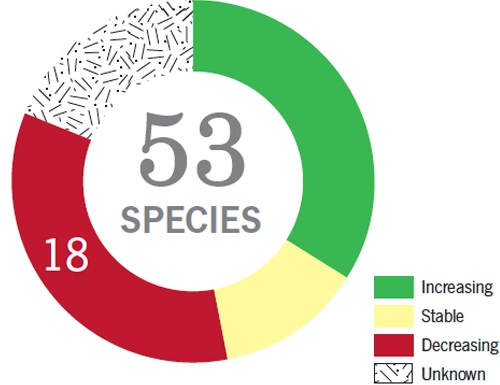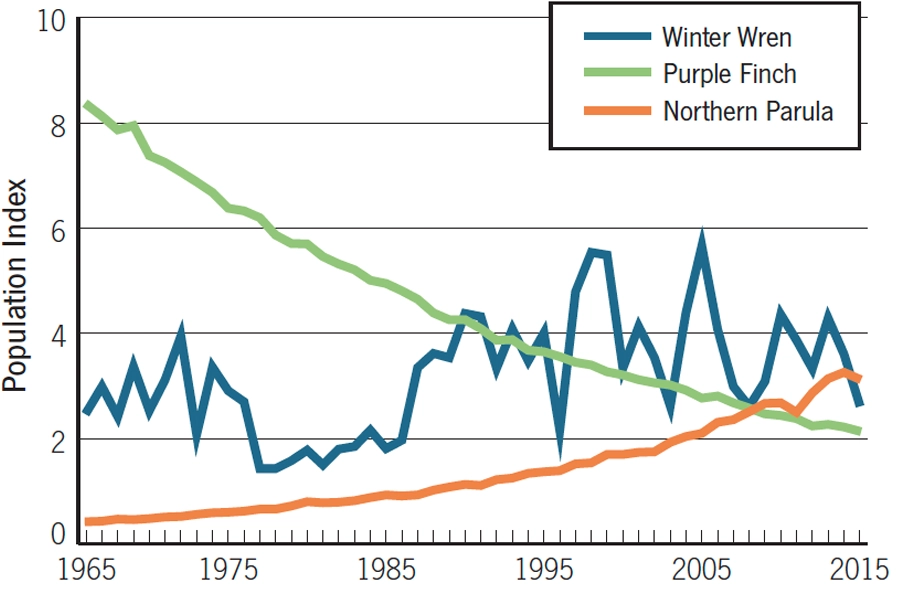Spruce and fir dominate the vast boreal forest zone that stretches from the Canadian Maritime provinces and northern New England west across Canada to the Rocky Mountains and beyond to Alaska. In New Hampshire, most spruce-fir forests are restricted to the north and west, with isolated pockets in highlands and peatlands in the southeastern third of the state. Spruce-fir forest includes four habitats from the WAP: lowland spruce-fir, high-elevation spruce-fir, northern swamp, and some peatlands. Roughly half the birds using this habitat in New Hampshire are spruce-fir obligates, meaning that they occur only in spruce-fir forests.

Spruce Grouse
Northern Goshawk
American Three-toed Woodpecker
Olive-sided Flycatcher
Bicknell’s Thrush
Purple Finch
Rusty Blackbird
Cape May Warbler
Bay-breasted Warbler
Canada Warbler
Yellow-bellied Flycatcher
Canada Jay
Boreal Chickadee
Golden-crowned Kinglet
White-winged Crossbill
Dark-eyed Junco
Blackpoll Warbler

Of the 53 species that breed in spruce-fir forests, roughly one third are declining. These include a mix of wetland and edge species, such as Olive-sided Flycatcher, Rusty Blackbird, and White-throated Sparrow, and forest species, such as Boreal Chickadee, Bay-breasted Warbler, and Purple Finch. The birds that are increasing or stable are primarily mature forest species such as Yellow-bellied Sapsucker, Yellow-bellied Flycatcher, and Northern Parula. Trends are still unknown for many birds in this habitat, including secretive year-round residents (Spruce Grouse, Black-backed Woodpecker) and irruptive species such as crossbills which can be present in high numbers one year and absent the next.
Clear cuts in spruce-fir forests often produce hardwood stands that are less suitable or unsuitable for spruce-fir birds. Shorter rotations between harvests reduce the amount of older, mature forest that some species require, including birds that depend on periodic outbreaks of insect pests such as bark beetles and spruce budworm, which build up only in mature forests or extensive forested landscapes.
Although our forests and birds have evolved alongside pests such as the spruce budworm, trees often have no defenses against non-native species such as the balsam wooly adelgid (an aphid relative). As these insects spread there is risk of high tree mortality, with unknown trickle-down effects on the birds that use these habitats.
Climate change has special implications for this boreal habitat, which could be restricted to smaller and smaller areas in New Hampshire as a warming climate makes growing conditions less ideal in southerly and lower elevation areas. For more detail see the Threats To New Hampshire’s Birds – Climate Change section on this pervasive threat.
New Hampshire’s high elevation spruce-fir forests are particularly susceptible to acid deposition, which has caused high red spruce mortality. Although air quality regulations have significantly reduced this threat, there is evidence that it may be compounded when trees are under additional stress related to climate change.
Implement timber harvest practices that ensure a variety of different-aged stands with trees of various sizes and density, including mature spruce-fir forests. We are fortunate to have large protected areas in the White Mountain National Forest and Coos County that can function as reserves, where careful management and natural processes can maintain appropriate habitat conditions for this group of birds.
Many spruce-fir forest birds are secretive, rare, or in hard to reach areas. We need more information on where they occur and in what numbers to better determine which additional species should be conservation priorities. There are opportunities for citizen-scientists like you to help fill in the information gaps. See Conservation for more information.
Many threats faced by birds are tied to the habitats where they breed. Explore the habitats and learn more about each one’s characteristics, population trends, threats, and conservation actions.
Information for the species profiles on this website was compiled from a combination of the sources listed below.
The Birds of New Hampshire. By Allan R. Keith and Robert B. Fox. 2013. Memoirs of the Nuttall Ornithological club No. 19.
Atlas of the Breeding Birds of New Hampshire. Carol R. Foss, ed. 1994. Arcadia Publishing Company and Audubon Society of New Hampshire
Birds of the World. Various authors and dates. Cornell Laboratory of Ornithology.
Data from the Breeding Bird Survey
Data from the Christmas Bird Count